Protein-packed, fluffy egg bake recipe
Egg bake is one of my favorite foods to make, for several reasons.
The recipe is tailor-made for food prep – meaning you get multiple servings out of every batch, no added effort required.

The perfect egg bake doesn’t exi-OMG, it’s so good.
It’s a nutritious food you can use as a solid “vehicle” and eat a dozen-plus different ways – top it with salsa or avocado, serve alongside breakfast meat, pair it with a side of veggies, soup, or about a million other side dishes. Egg bake is a great base to make a delicious, nutrition-filled (and stomach-filling) meal. I have young children and they love this egg bake recipe – which says a lot.
Finally, one of the greatest things about egg bake – it’s perhaps the only food that tastes better reheated after being frozen. True story.
A potential downside of egg bake? It can taste pretty meh if it’s not done right. If you’ve ever been personally victimized by dense, heavy, or dry egg bake, I assure you – this egg bake recipe is having none of that.
Without further ado: a protein-packed, fluffy egg bake recipe.
Ingredients – and in the order you’ll use them:
8 large eggs and 1 cup egg whites (or 10-12 large eggs)
1/2 cup flour (you can sub half wheat flour or try gluten-free flour – changes the texture a bit but still works)
1 tsp baking powder (THIS is crucial – do NOT skip the baking powder)
1/2 tsp salt
1/4 cup melted butter
1 pint cottage cheese
Preheat the oven to 400 degrees. Beat the eggs (and add egg whites, if using), then mix in flour, baking powder, and salt. Scrape the bowl as you combine well. Add the melted butter and mix, then finally mix in the cottage cheese. Bake at 400 degrees for 15 minutes; reduce heat to 350 degrees and bake another 36-37 minutes.
This recipe delivers a protein-packed, fluffy egg bake you can serve right away. I make it every year for Christmas brunch and it’s always a hit. Or, throughout the year, I make this often, then divvy up into 8 servings, refrigerate or freeze, and have ready to go whenever the mood strikes. It’s delicious, it’s nutritious, and it can be eaten numerous ways.
And I didn’t mention it before, but you can gather from the above instructions, this is an easy recipe! Anyone looking to eat healthier, eat more filling, nutritious food, and practice food prep, you’ll want this recipe. Eat well!
That’s enough for now. Until next time,
Lindsay
One thing The Biggest Loser did right
Say what you will about The Biggest Loser – for real, a lot of people are saying a lot of things about it lately. And most of them aren’t great.
Thanks to a new behind-the-scenes series of interviews from people involved, The Biggest Loser is seeing new light. And it’s not the rosy, warm light of your bedroom. It’s the harsh, unforgiving fluorescent lights of an old-school department store fitting room.
The TV show once beloved for its ability to help people transform their lives crashed and burned nearly 10 years ago, aside from an attempted revival in 2020.
I watched The Biggest Loser in the middle of its heyday. It was around the time I began making healthy lifestyle choices that I desperately needed after hitting my own rock bottom. I think I loved seeing others, seemingly, achieve success; their own version of the same success I had from trading poor habits for exercise, drinking water, and eating more nutritious, real food.
But, deep down, I knew it wasn’t right. What they were doing wasn’t sustainable. And it sure as hell wasn’t a healthy approach to the most important thing we should all be seeking: overall wellness.
I knew, and I think other people came around to the fact, that weight is just one aspect of a person’s complete, well self. And extreme, unsustainable practices typically won’t lead to a long-term healthy lifestyle.
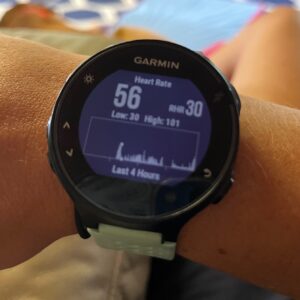
Less about the number on the scale – more about numbers that really matter, like resting heart rate.
Out of curiosity, I watched all three episodes. Overall, people didn’t say a ton of great things about it and the show did not come off well.
However, I would like to focus on the positive and talk about one thing The Biggest Loser did right. Unfortunately, it was the aspect that the show spent the least amount of time on: proof that healthy habits improve health.
How to get healthier
The Biggest Loser was, at its core, a contest. It was more of a game show than a reality show, with a six-figure prize for the person who went the most extreme and outlasted everyone else.
Like any TV show, it was hallmarked by all the sensational and sexy moments, from the painstaking workouts, to vilifying food with “temptations” and, of course, all topped off by the infamous scale. WAAAYYYY too much focus on the scale.
The show spent the least amount of time on, arguably, its true shining star: health. Improving health.
While only a blip across the entire series, there were moments the contestants stepped away from the scale and saw their true health improvements.
Many saw their blood pressure drop to normal levels. Others saw cholesterol levels move into healthy range. I recall a few who eliminated their Type 2 diabetes.
That’s right, they didn’t just kill it on the squat rack. They killed their chronic diseases.
And THAT, my friends, is what The Biggest Loser got right. It proved that when you exercise, drink water, and eat more nutritious, real foods, you CAN – and WILL – improve your health.
Your health is in your control
This is important to recognize, perhaps now more than ever.
Personal health and wellness is in a poor state in our country. There are influential voices trying to make us believe that health problems are all “just” genetic. That chronic disease “just” happens and is out of your control. This idea that you “just” can’t do much about your health.
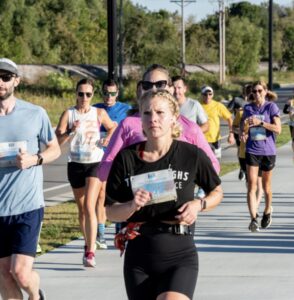
You CAN do it.
So, what, we should “just” accept it? That’s bullshit.
Everyone is dealt a different hand but everyone can make healthy choices. In a world where there’s a lot out of our control, your health is in your control. You have power to make it better or worse.
I’m living proof of this. I’ve seen other people who are, too. Throughout all its faults, The Biggest Loser showed us this.
Healthy habits are boring – in a good way
While The Biggest Loser missed the mark in promoting it, the show’s greatest success was the most important aspect of the healthy lifestyle habits it was preaching.
Yes, exercising, drinking water, and eating nutritious food WILL improve your health and, perhaps better, quality of life.
As for the weight? I hate talking about weight. It pains me to admit, technically, yes, sure, your weight matters – but only to a degree. It’s definitely not what matters most.
Your heart and brain health, functional and mental strength, endurance and sleep, bone and joint health – those are a few examples of what matters most. And I truly believe you can be healthy and well in a variety of shapes and sizes.
Perhaps The Biggest Loser’s downfall was also why we’re still talking about it – it was a successful TV show that boomed into a profitable brand.
I get that it wouldn’t be compelling to create a TV show that teaches people habits of smart grocery shopping and nutritious cooking. Viewers may not tune in to see someone managing glucose spikes or meeting their daily fiber requirement. It wouldn’t be sexy to show people taking brisk walks every day, drinking water, and going to bed at a reasonable hour.
And that’s the funny thing: healthy lifestyle choices are incredibly boring. And I mean that in a positive, hopeful way! People seem to believe that it’s complicated to be healthy and well; that it’s a series of secrets or hacks that only the most successful people know.
A healthy lifestyle boils down to doing simple things consistently. It’s choosing water more often than soda or alcohol. It’s food prepping for the week and eating at home in favor of going out to eat or ordering Door Dash. It’s waking up and going for a walk versus immediately scrolling the phone.
Healthy habits – not made for TV…yet?
“You can’t have a show based on weight loss that’s safe.” This quote, from The Biggest Loser’s doctor and medical consultant was the one I jotted down because it stuck with me.
Maybe you can’t have a TV show that shows healthy lifestyle habits while being compelling enough to score ratings and product partnerships and all the money-making things. Maybe no one really wants to see a show that focuses on, not how much weight people lost, but what they gained in health – physical, emotional, social, all aspects of wellness. Maybe people aren’t interested in practical, lifelong habits they can put into action every day.
I mean, I’d love to watch that show – in fact, I’d like to volunteer to host that show. Maybe some day…
That’s enough for now. Until next time,
Lindsay
How running a marathon can boost career success
Stress management. Better sleep. Heart health, optimal blood pressure, and strong muscles.
Of all the positive outcomes that comes with running, there’s another slew that I rarely talk about but benefit from nearly every day. Perhaps because these benefits show up in a place that isn’t as obvious: at work. Yes, I’m talking about how running can help your career.
Running for career success
When thinking about people who are successful at work, I don’t know that many people would instantly picture a runner. I feel like most minds jump to visions of the people who grind, dominate conversations, pull all-nighters, talk loudly in the weekly team meeting, and wear their “busyness” as a badge of honor.
But, I believe there’s another type of successful person in the workplace. The person who’s mindful before they speak, who’s intentional about their approach, and who can ruthlessly prioritize rather than call a fire drill on every project. There are solid workplace skills that can be built and reaped through the planning, discipline, and work ethic of running, particularly, marathon training.
Earlier this year, while in the thick of marathon training, I was thinking about the parallels of marathon training and my professional job. I shared a quick post on LinkedIn and it resonated really well, so I wanted to share on the blog.

Adapting to the unexpected is a hallmark of workplace success – and you’ll get plenty of that while marathon training.
Here are 5 ways that, for me, marathon training offers reminders that boost career success. Maybe these skills and reminders can help you, too.
1. Strategy
Training for a marathon means setting sights on a goal, working backwards to create a plan, then dialing in what’s needed every day to meet that goal.
It reminds me to approach work projects the same way, with the goal in mind first, rather than jumping in on tactics or a shiny new object.
2. Flexibility
While marathon training requires discipline and sticking to a schedule, it also requires flexibility. It may mean moving a run day, adjusting mileage last-minute, or skipping a run altogether.
It reminds me to keep this sort of contingency planning (dare I say, crisis management) mindset at work; even the most perfectly well-thought out plan likely will require a pivot at some point. Side note, this has been an important skill to draw on in my parenting life, too.
3. Details
Running is about more than the miles. It’s about fueling well, good sleep, hydration, scraping, chafe prevention, taping, and about a hundred other things.
It reminds me details matter. Missing one small thing once isn’t a big deal but lots of small misses can add up.
4. Post-work
Recovery after a run is crucial to health and the success of the next run.
It reminds me of times I’ve completed a project, then immediately moved onto the next – but that pause for reflection is just as important as any other part of the project and can set up success for the next one.
5. Focus on what you can control
After nearly 20 years of distance running, this one is still tough. As a runner, there’s so much out of your control. You can eat well but your stomach or energy level is just off. You can plan a 20-miler when weather looks good, then Mother Nature decides to throw out a storm. But we still keep running.
It reminds me that in work – and in life – even though there’s a lot out of our control, we can focus on what matters and still keep going.
That’s enough for now. Until next time,
Lindsay
What is nutritious food – why it matters more than healthy food
“Is this healthy food?” “Is this unhealthy food?”
Lately, I’m noticing more interest around healthy food. On one hand, this excites me to no end. I love conversations about food, in general. And I especially love people taking a genuine interest in embracing food as an opportunity to fuel their body, fight diseases, and feel their best.
But, I think this interest on healthy is focused on the wrong concept. It’s also asking the wrong questions. What really should be the concern is nutrition. And the questions we should seek to understand: “Is this nutritious food?” “Does this support my nutritional needs and goals?”
Why focus on nutritious food
I’m really passionate about focusing food conversations, first, on nutritious food. I think people use the word “healthy” when they often mean nutritious, or use them interchangeably. But the two are different and worthy of their own categories.
Healthy food is incredibly subjective, in context and in the greater scheme of who we all are as unique people with unique health choices, lifestyles, and needs. I’ll get into that later.
The other, and perhaps larger reason I hope to see a shift in conversations towards nutritious over healthy, is there’s a lot of bad advice and inaccurate information out there on healthy eating. Restrictive diets, categorizing foods as “bad,” and failing to see the real point – nutrition is most important – is all unfortunate. I once saw an influencer bash berries and carrots – nutritional powerhouses – because they contain sugar. This is what we’re up against.
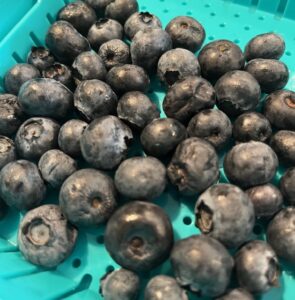
Fear no food – especially ones packed with nutrition.
I am here for none of that. Diet philosophy that preaches restrictions, rules, what you can’t eat, and what’s “bad” food is garbage. All it does is create more confusion and fear around food.
I’m also very concerned about the unbelievable reality we’re all witnessing, the pushing of semaglutides, i.e. GLP-1s like Ozempic and Wegovy.
I won’t get deep into that but I will say, one of my biggest concerns there and that relates to this conversation: we are not in need of less food. We’re in need of more nutritious food, quality food, the foods that fill and fuel us.
This is why I want to dive into the topic of nutritious food. My hope is to help simplify a topic that has become very complex and instill a sense of positivity around food.
Because food is here to nourish our bodies, fuel us to be our best, and is something to enjoy as we connect with others, celebrate occasions, and live each day!
What foods are nutritious foods?
I define nutritious food as food eaten with the purpose of nourishing your body with nutrients and other good things it needs to function at its best.
A seemingly simple question like, “Is this bread healthy?” does not have a simple answer. It lacks personalization. Healthy…for who? For me, the answer may be different than for you. It also lacks context. Healthy…like this wheat bread, compared to white bread?
A question like this, however, “Is this bread nutritious?” has a simpler answer. That’s because nutritious food is fairly non-subjective, especially when we’re talking micronutrients.
Nutrition conversations do get a little more complicated when talking about macronutrients: carbohydrates, fats, and protein. A few quick rules of thumb for those:
-Choose quality carbs, especially fiber and natural sugar – that’s right, sugar is not bad!
-Opt for natural sources of protein, like eggs, beans, spinach – real food sources over processed.
-Don’t skip healthy fats, like avocado and olive oil, real butter, and nuts – full-fat is not bad!
Because macros get complex, depending on so many personal health needs and lifestyle choices, I’ll focus more on micronutrients. These include vitamins and minerals, from the well-known calcium and iron to the quieter powerhouses like magnesium and potassium.
There’s also “nutrition” that comes from antioxidants and probiotics. Even water should be considered nutritious because of its power to naturally detoxify the body and keep it functioning at its best.
I’m so passionate about nutritious food because of all the benefits the right balance of nutrients can bring. When eaten regularly, nutritious foods can prevent, even reverse chronic diseases, tame inflammation, keep your gut healthy – which can also keep your brain healthy, because of how linked the gut and brain are in the body – and fuel you with energy and focus.
And, because it has to be said, a nutritious balance of foods will naturally help manage weight. No judgment because we all do this – but think about how easy it is to eat half a bag of chips or pint of ice cream and not even feel full. Now think about eating 3 bananas, a head of cauliflower, or an entire bag of spinach. I feel full just reading that.
How to choose nutritious foods
All that said – how do you know what’s nutritious food? On the most basic level, much of our nutrition comes from the foods you probably already think of as “healthy” like berries and sweet potatoes, fish and eggs, beans and seeds, oats and quinoa. There are also powerful spices like cinnamon, garlic, and turmeric that have nutritional and whole-body benefits.
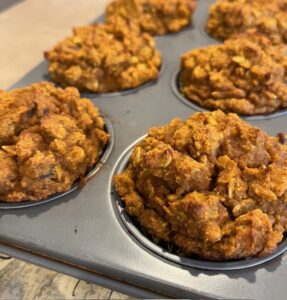
Cooking at home is one of the best ways to ensure you’re eating nutritious food
Outside of those more obvious, and because no food is off-limits, it’s important to learn how to read labels on anything packaged. Notice how many ingredients are in something – some you may not recognize and that’s okay! Just start being more aware and pausing to look.
Building on the idea of inclusive eating and enjoying a variety of foods, not every food you eat has to be a direct source of nutrition. Some can be, as I like to think of it, vehicles for creating nutrition.
Let’s go back to bread. I’m sad how it’s been vilified because bread isn’t bad. It’s not fair to call it “unhealthy” and just leave it at that.
Instead, let’s ask the right question and take it a step further: Is it nutritious? Not really, no – but a sandwich can be. Add cheese and pile on the veggies to basic bread, boom. Or, top a slice with fried egg, roasted tomatoes, and avocado. Nutritious and delicious!
On the flip side, if asked “Is salad healthy?” most people would say yes! The nutritional truth is a lot of lettuce varieties don’t offer much of it and store-bought salad dressings are often loaded with sugar and excess ingredients, not nutrition. However, a salad can be super nutritious. Mix spinach with the lettuce, add a ton of veggies, sprinkle in some quinoa and cheese, and toss in chicken or beans for a protein boost. You can make a delish salad dressing with ranch seasoning, a little mayonnaise, and Greek yogurt – and the yogurt will give you bonus probiotics for good gut health!
Start to build your own nutritious eating habits by finding reputable outlets (not influencers) to do your research. Begin checking labels. Cook as many whole, unprocessed foods as you can.
And be mindful to learn what you really need out of your food and what works best for those needs. A woman in her late 40s has different nutritional priorities than a man in his early 20s. Both need nutrition – but one may be more interested in a combination that supports peri-menopause symptoms while the other may seek more carbs and iron.
These steps add up to a great recipe for more nutritious eating. Bonus, nutritious food fills you up and gives your body what it needs, unlike ultra-processed food that offers no nutritional value and leaves you hungry for more. You don’t need a diet pill, you need nutrition.
What foods are healthy foods?
Okay, okay – I’m not against the idea of healthy food. I love health and wellness, across the board, in general. So allow me to explain why it’s different than nutritious food.
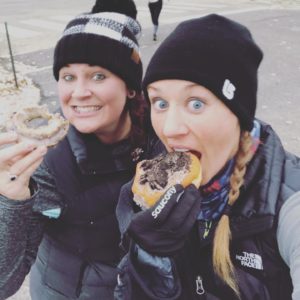
Enjoying a donut – with a friend – while running a 5k – feels very healthy to me!
I define healthy food as food eaten with a purpose to fuel your body, mind, or, in some cases, happiness.
Healthy food seems like it would be an easy concept but it’s more confusing than nutritious food, because things get really subjective and can be even more personal than nutrition.
Back to the bread. I’m a fan of bread. As an endurance athlete, one of my favorite pre-run breakfasts is toast with peanut butter and a banana. It gives me great fuel to tackle marathon-distance miles, while sitting well in my stomach. So, is bread healthy? In this scenario, absolutely yes.
For someone who’s not as active or needs to closely manage their blood sugar, that may not be the best breakfast to optimize their health. So the answer to, “Is this food healthy?” is really different from one person to another, even one scenario to another.
A final note about healthy food. Perhaps the trickiest thing about choosing healthy foods, whether in a grocery store or even when out to eat, is marketing. Organic, gluten-free, fat-free – these words do not equal healthy. Food has been cleverly marketed for years to make us believe things are healthy or at least healthier than a similar option. But all those words are is marketing (unless, in this example, you have Celiac Disease).
People are probably sick of hearing this but it really boils down to balance. Mostly nutritious foods most of the time leaves plenty of room for other foods and give an overall sense of balance.
If you’re trying to improve your health and wellness, and are looking harder at your food as a way to do it, big high-fives. I may say that it’s simple – but please know that I do not think it’s easy. Eating a nutritious, balanced diet is really hard. I hope this gives you a better sense of how to get started and helps along the way.
That’s enough for now. Until next time,
Lindsay
10 tips to exercise: What we can learn from kids
Adults need exercise. Full stop. No wiggle room. That statement is a hill I will die on.
You, reading this, hey! You need exercise.
Sometimes though, adults over-complicate exercise. There’s this idea that is has to be a HIIT workout, a long run, or a full-on spin class to “count” as exercise. Otherwise, eh, not worth it. And the “too busy” excuse becomes just too easy of an excuse.
Wrong. Movement is what matters. And ALL movement counts.
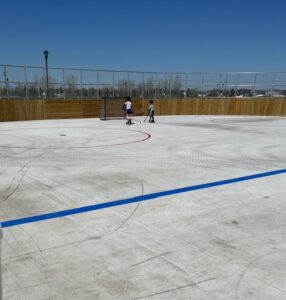
Join in for some fun play – or walk laps while the kids play. Everyone wins!
My latest blog for Fargo Mom takes a note from the best exercisers of all-time: kids. They don’t make it complicated, they play! Kids are inherently built to move. And they do. Then, they move some more.
If you have kids and feel “too busy” to exercise, here are 10 ideas to make time for exercise, from the original Fargo Mom post. It’s 10 easy and simple ways to exercise – by combining quality time with your kids and movement.
If you don’t have kids, feel free to steal an idea or this concept. Go for a bike ride. Join a rec soccer league. There’s an activity, a sport, or an exercise out there for everyone to enjoy.
And, if all else fails, go back to my philosophy: THEE most underrated exercise of all time is walking. Go for a walk.
That’s enough for now. Until next time,
Lindsay
Top Questions About Running a Marathon
Like nutritious food, the music of 311, and anything Andy Samberg is doing, running is something I always want to talk about.
Naturally, when a friend recently asked me if I’d talk to her son about running his first marathon, I couldn’t say “yes” fast enough.
That’s right – this time, somebody DID ask me what I’m going to write about here.
I was giddy to talk to this young man, John, about running. And I’m thrilled to share answers to 5 of his top questions for anyone else who may have questions about running a first marathon.
My Standard Disclaimer About Everything
Before you dive into these running FAQs, keep in mind the first thing I said to him, which is my standard disclaimer for running, eating, parenting, pretty much everything: What works for me may not be what’s right for you.
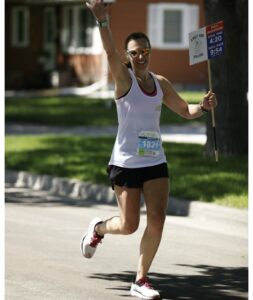
You don’t have to run a ton. Just run.
While none of these will be one-size-fits-all answers, they’re pretty solid best practices and based on experience, success, and my favorite thing, common sense. For most people, these should be a great starting point to get started running, whether running a first marathon or other running goal.
Question 1: When should I start training for a marathon?
The short answer: Train for a marathon. Please, just train.
The longer answer: I am not supportive of running a marathon without training. People seem to be doing it more and more frequently, or at least there’s more humble bragging about it.
In addition to my personal beliefs that I won’t get into, it’s straight-up not healthy for most people to run a long distance without training for it. Depending on experience and base mileage, marathon training could be just a few weeks for someone. And for others, starting a few months pre-race might be best.
John asked this question a solid 3 months before the race. So the easy answer was that he was already putting himself in a great position to have an awesome race day.
I further encouraged him to think thru his plan by working backwards. Start with the race date, then plot out weekly long runs in a backwards way to allow time for tapering, lower mileage weeks (or “de-load” weeks as I described it, knowing his weight lifting background), and flexibility to build up gradual and strong while still allowing for life to happen.
Question 2: How much should I run?
The short answer: Aim for consistency, build the weekly long run, and take 1 rest day each week. Most important, do not take advice from “influencers” on social media unless you really trust them.
The longer answer: There’s no magic number of weekly runs or mileage one must hit. Consistency is where it’s at; just keep running every week, week to week. Aim for a long run every week and gradually build up that mileage to run a 20-miler 2-3 weeks ahead of race day.
I also believe there’s a lot of power in taking a rest day. Not an active recovery day, not a light day, like a full-on rest day. Rest isn’t lazy, it’s productive and it’s good for mental and physical wellness.
As for what the “influencers” may say? No. You don’t need to run 100, 75, or even 50 miles a week to properly train for a marathon. In fact, it’s probably best you don’t.
There’s nothing wrong with those high-mileage weeks for some people, typically very seasoned and ultra-runners maintain those levels with no issues. For a lot of people tho, that much running is nothing more than a recipe for burnout and injury.
Focus on consistency, the long run is your BFF, and never feel guilty for taking a rest day – or a few!
Question 3: Should I run fast or focus on distance?
The short answer: It depends on your goal but in most cases of a marathon, distance is the priority.
The longer answer: If you have a goal finish time, by all means, work to a goal pace. However, trying to do every run at race pace may be counterproductive. I recommend planning weekly runs with a mix of tempo and intervals, and always at least one easy pace run every week.
If you don’t have a goal finish time, try to find a pace that feels okay and is not too hard. Especially on the long run, you don’t want to go out too ambitious, then run out of steam before you hit the distance goal. Focus on distance, again, primarily by building up your body’s endurance with that weekly long run.
Question 4: Can I still lift weights?
The short answer: You can and you should lift weights when training for a marathon.
The longer answer: Especially for people who are used to regular lower and upper body lifting, there’s no reason marathon training should sideline that important work. In fact, it’s great to get out of the “miles, miles, MORE MILES” mindset and do other forms of exercise, including weights.
My only caveat here is that a reduction in frequency and intensity may be needed, especially during peak mileage weeks. Marathon training burns a lot of calories. In my experience, it’s not as easy to build or even maintain the same levels of weights when running a ton of miles, even with increased calories that come along with marathon training.

Carbs. Fruit. A little whipped cream? Eat it all!
Keep lifting, just keep that expectation in check so you don’t feel bad or push too hard. Better yet, shift your mindset to think of weight lifting as helpful injury prevention and strengthening your body to handle all the miles.
Question 5: What should I eat?
The short answer: Anything and everything! Yes, I love food so I saved the best for last.
The longer answer: Still anything and everything! My only suggestion is be mindful and learn what foods fuel you best. Because your body is different than everyone else’s, there isn’t one, gold-star eating plan that every runner must follow for optimal results.
What gives you enough energy to sustain those 8, 15, and 20 mile runs? What dinner leads to a calm stomach the next morning? What foods meet your individual needs, like taming inflammation, boosting immunity, or promoting muscle recovery?
In marathon training – and in life – I believe no food is off limits. Every fad “diet” seems to be about what you can’t eat, so restrictive. Instead, healthy eating should be about filling up with more – more nutrition, more of the good stuff, more that keeps your tank full and your body strong.
Ice cream before a long run upsets your stomach? Yeah, okay, you might want to eliminate it the days leading up to the weekly long run. But, in general, focus more on feeding yourself what fuels you best rather than thinking you should only be eating certain foods – or, worse, that you need to stay away from certain foods.
If you can’t tell, I’m really passionate about seeing food as an opportunity to nourish and fuel the body, not something that’s evil or the enemy or that should be avoided.
Keep On Running
For anyone who’s still reading and interested, John crushed that first marathon. I chatted with him leading up to the race and after. He felt strong and ready, and finished with a smile on his face. And, like many runners, it only took a couple hours after the race and he was already planning his next marathon.
Whether you’re looking to tackle a marathon or start with your first 5k, I hope these running FAQs help you run strong, healthy, and happy.
That’s enough for now. Until next time,
Lindsay
How to Get Better Sleep – Nothing Expensive Required
As much as I love the winter, there’s something to be said for the amount of daylight that comes during the rest of the year.
Interestingly, thinking about more daylight this time of year made me think about sleep. Perhaps because I have young children who now go to bed when it’s still light out!
Additionally, I recently watched a show that included a segment on how to get better sleep. I was unsettled to see the focus was primarily on products, not tips, for better sleep. And I’m not talking about inexpensive, reasonable products that are great sleep hygiene investments, like blackout curtains or a white noise machine.

Burton – the king of great sleep.
This “informative” show framed up the key to better sleep coming from expensive technologies and products. Actual, helpful (and free) tips to improve sleep were buried, barely a focus.
While I don’t imagine these technologies and products hurt sleep, I don’t believe it needs to be so complicated and expensive.
I am a believer in sleep hygiene. Adopting a series of healthy habits, both directly and indirectly related to sleep, can add up to good sleep hygiene and, ultimately, better sleep.
Common sense sleep
I recently wrote about common sense wellness tips; the obvious and simple ways to improve health. One of my key points was that there are no amount of hacks or tips – or expensive products – that will lead to wellness. The real “secret” is common sense; doing the things you already know about but aren’t doing or aren’t doing consistently.
Sleep is in that same realm. Quality sleep is so important to wellness, yet I intentionally did not include “Sleep better” in that article with my top 5 wellness tips. Because, sleep isn’t something you can just decide to do as easily as the others.
You can’t set and achieve a goal to sleep for 8 hours every night in the same way you can set and achieve a goal to do any of the other 5 things on that list; drink 8 glasses of water a day, for example. Unfortunately we can’t directly control the ability to sleep in the same way we can control our ability to drink water.
However, we can focus on things in our control that can lead to better sleep. In the spirit of that article, I’m going to recap it and tie sleep to each of my top 5 tips for health and wellness. Before going out and spending hundreds of dollars on a headband that promises better sleep, consider trying these common sense tips for better sleep.
1. Exercise consistently
Research consistently shows that exercise leads to, not only better sleep, but better quality sleep. The best part is “exercise consistently” doesn’t mean running 40 miles a week or taking CrossFit classes every day. I’ll give my favorite PSA here: Walking is the most underrated exercise and can be done by virtually everyone!

Exercise outside to soak up the daylight.
2. Eat real food
A body that’s full of heavy, processed foods that are packed with sugar or salt isn’t poised to sleep well. Real, nutrient-rich foods, especially protein and fiber-filled, are linked to the ability to fall asleep faster and get better quality of sleep.
3. Drink water
Alcohol, soda, and other sugary or caffeinated drinks are counterproductive to good sleep. Water, on the other hand, is the best beverage you can put into your body. Just don’t drink too much right before bed or your sleep may be interrupted by a call of nature.
4. Save don’t spend
Does anything keep people up at night more than worrying about finances? While some financial stress is out of our control, wasteful spending can be controlled. It may be “buy one, get one free” but if you don’t need either, is it a great deal?
5. And for the love of all things, put away your damn phone
Screen time isn’t helping anyone fall or stay asleep, it’s making both harder. The first step to better sleep isn’t to buy a fancy gizmo or gadget, it’s to get off the phone – which, p.s., is trying to sell all those gizmos and gadgets at every click, swipe, and scroll.
In addition to healthier habits, adopting simple sleep hygiene tips can help encourage better, more restorative sleep. A consistent bedtime and wake-up time every day is a good start.
Similar to common sense wellness, simple, consistent habits done every day can add up and pay off with better sleep.
That’s enough for now. Until next time,
Lindsay
Healthy habits: Learn to cook and eat real food
Something awesome happened to me last year. After nearly two decades of being a runner, I had, perhaps, my strongest running year ever.
Rather than brag by sharing WHY it was so great, I’d like to jump right in and get to the more important point of HOW it happened. I’ll go into the WHY later.
Having my best running year wasn’t because I ran more or ran faster. I didn’t up my weight training. And it definitely wasn’t because of the latest health gizmo, gadget, or supplement that promised to be a game-changer.

Marathon #3 of 3 last year – success!
2024 was my best running year to date because I ate healthier and I learned how to cook.
Learning to cook and eating real food
Let me back up. I’ve always sort of known how to cook. I have my go-to foods and I can follow a recipe.
Likewise, I’ve consistently been eating healthy, even healthier every year, since my mid-30s. More spinach, protein, and whole grains; no alcohol, fewer processed foods, and less eating out (that last one, mostly thanks to having small children).
But last year, I really invested in learning to cook, and in learning more about truly healthy eating and better foods to fuel and nourish my body.
So, what changed?
On the eating side, I dug deeper into anti-inflammatory foods. I researched foods that help with perimenopause symptoms. I started looking much closer at food labels and realized there’s so much garbage in “healthy” foods, or so they’re marketed to be.
Then, the cooking aspect really brought it all together.
A few tools in the health toolbox
Now for a confession: I don’t like to read. Like, at all.
I know I should feel embarrassed or like I should try to discover joy in reading. After all, reading books is all the rage, especially for women and especially for working professionals. But no, no thank you.
I have, however, found a book that I love to read. And it’s a cookbook: Run Fast. Cook Fast. Eat Slow.
Whether this book (highly recommend, even if you’re not a runner!) or something else, I think a great first step to learning how to cook is to find easy recipes that call for clean, quality ingredients.
Another thing that helped me learn to cook was having a few good tools. It’s not imperative to have every gizmo and gadget to cook well. Keep it simple with a few basics – most of which are probably already in the kitchen – that will get a ton of use.
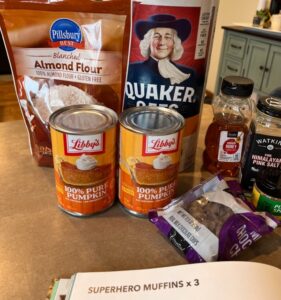
My favorite recipes are also the healthiest ones.
I have a big wood cutting board and one good chopping knife. I often use a whisk and a garlic press, as well as measuring cups and spoons. It’s imperative to have at least one pot and pan, and, depending on what you’ll make, baking dishes and mixing bowls of varying size. An Instant Pot or even an old-school crock pot are also very useful.
Healthy habits – start small
I believe true healthy eating – including learning to read food labels and learning how to cook real food – is one of the best things anyone can do to improve their health.
I’m also a strong advocate for regular physical activity and drinking water. Those three are a real trifecta and when all combine, can have a ripple effect that encourage more healthy habits, like better sleep, greater mindfulness, even help foster a gratitude mindset.
If you’re interested in learning to cook and eating healthier, just start small.
You don’t have to throw out everything in the pantry and never buy packaged foods. You can make a positive impact by starting to incorporate more real foods into your diet.
For example, skip the boxed macaroni with a packet cheese and make your own with real cheese and real butter (it’s easy and essentially the same process). And boil in some broccoli with the pasta for the added veggie kick.
Or, make your own batch of soup from a packaged mix – but add a bunch of veggies, some beans or chicken, or even tofu. And sprinkle in powerful spices, like garlic and turmeric.
Look at labels and start by noticing how many ingredients are listed. Compare a bag of Fritos with 3 ingredients to a “healthy” protein bar that has more than two dozen, most of which the average person can’t pronounce. IDK about you but I’m opting for the Fritos all day.
Still running strong
And now, for anyone who’s still reading, I’d like to share the details about WHY this was my best running year.
Not only did I return to running full marathons, something I hadn’t done in almost five years, I ran three of them. I had never run three fulls in one year. Adding icing on the cake, I paced all three of them, made it under goal pace, and finished with a smile on my face and pep in my step. And perhaps the best part of all, I trained and ran them all injury-free.
Oh, and a few more things: I’m in my 40s. I’m deep into perimenopause. I have 2 young kids and a full-time job. I wouldn’t call now the time in my life that thriving is exactly expected. But I’ve never felt healthier.
I hope this year brings you the best, healthiest one yet!
That’s enough for now. Until next time,
Lindsay
An Easy Way to Eat Healthier: Embrace Food Prep
Meal prep is a trendy concept and brings a lot of advantages. Whether looking to improve financial wellness by cutting down on costs of “convenience” foods (think prepackaged meals and cut fruit from the grocery store, or expensive takeout and ridiculously expensive delivery) or saving time in the long run, meal prep is great for both. Then there’s, perhaps, the biggest benefit of all: meal prepping can help you eat healthier.
Now, let’s be real: Full, complete meal prep is also hard. It takes thought and creativity to plan meals. It takes time to cook said meals. And there’s a degree of commitment to eating those same meals multiple days in a week – even in a row.
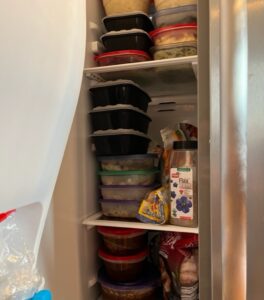
Me: You can never do too much healthy food prep!
My overstuffed freezer: I’d like to weigh in on that…
I’d like to offer an easy way to eat healthier; an option that brings the benefits of meal prep but is more realistic, flexible, and simple: food prep.
The simpler idea of food prep is, rather than making full meals, in bulk, ahead of time, making more standalone foods, still in bulk, still ahead of time. Think things like hard-boiled eggs, sweet potatoes, or a pot of soup. Other ideas are chicken, browned hamburger meat, and a batch of quinoa. Even just grating your own shredded cheese or washing and cutting up veggies and fruit – great ideas for simple food prep that can bring big impact.
Food prep is a win when it comes to budgeting. Choosing versatile foods to prep ahead of time also means less work when it comes to making a healthy, filling meal or snack. It’s an easy way to eat healthier and delivers all the overall wellness advantages of meal prep without as much time and commitment.
I originally wrote this post for a Fargo Mom article, where I shared 10 of my favorite, easy food prep ideas. Read that full article for all 10 healthy foods to prep every week.
Or, simply take what you just read and get going now on prepping some of your own favorite, healthy foods!
That’s enough for now. Until next time,
Lindsay
Nobody Asked Me: Common Sense Health and Wellness
This is a post with information nobody asked me for and nobody needs. With an intro like that, buckle up for some good stuff.
On my mind today – and every day, really – is health and wellness. Recently, I was thinking about how people can over-complicate things. It started with learning more about Gen Z’s skin care obsession and has been amplified by seeing an absurd amount of ads for diet programs, weight loss consultants, and wegovy.
People seem to be on a constant and endless quest for health and wellness hacks, secrets, and tips.
But, the reality is, there’s no amount of hacks or tips that will lead to wellness. There aren’t secrets that everyone else knows about except you. It’s a lot of common sense; doing things you already know about but aren’t doing, or maybe aren’t doing consistently enough.
Everyone’s unique factors and personal situations can add challenges for some more than than others. But the basics are simple, there’s no need to over-complicate.
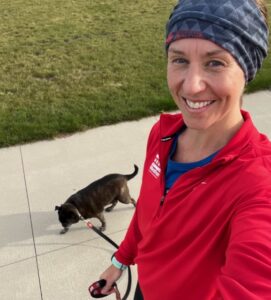
Exercise doesn’t need to be HIIT or running a marathon – it’s walking.
To try to be helpful, I’ve compiled 5 go-tos for common sense health and wellness. This is the information nobody asked for and nobody needs…because you probably already know it. Enjoy!
1. Exercise consistently
From chronic conditions to perimenopause symptoms, virtually every health issue can be helped – and, in some cases, solved or prevented altogether – by exercising. It also helps our sleep, improves our mood, and brings about a million more benefits.
Going for a walk, lifting weights, or any activity that gets you moving and a little sweaty is incredibly good for your health and wellness. You know this. So do it.
2. Cook real food
Right up there with exercise, eating real, non-processed food is almost always the solution to the problem. What’s not the solution? The latest diet fad or shelling out big bucks for consultants, programs, and products.
Eating real food – cooked at home more often than not – like vegetables, whole grains, eggs, and fruit, is incredibly good for your health and wellness. You know this. So do it.
3. Drink water
If I were to identify a trifecta of common sense health and wellness, water would be the third pillar. There are so many beverages that add poison, sugar, and other bad stuff to our bodies, while water is clean and powerful.
Drinking water is incredibly good for your health and wellness – including that of your skin (looking at you, Gen Z). You know this. So do it.
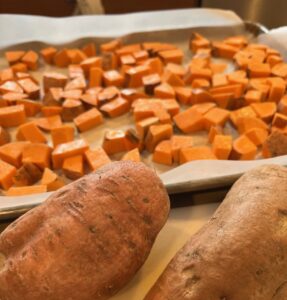
Cooking at home is good for your financial health, too. Win-win!
4. Save don’t spend
Financial is one pillar of the greater health and wellness picture that doesn’t often get talked about. Considering how much a person’s financial stress and clutter (i.e. too much stuff) affects sleep, mood, and overall health, financial wellness should be talked about more. But, we live in a world of industrial complexes, a world that wants us, trains us, and pressures us to spend.
Saving your money rather than spending it is good for your health and wellness. You know this. So do it.
5. And for the love of all things, put away your damn phone
Social media is killing your mental health. Endless scrolling is counterproductive to mindfulness. And all that screen time isn’t helping you fall or stay asleep.
Phones and devices are destroying our health and wellness. Of all the common sense I’ve shared, this is the one that we all really know. So, please, get off social media and put away your damn phone.
There you have it. Everything you ever wanted to know about how to get healthier and improve wellness…that you already knew.
That’s enough for now. Until next time,
Lindsay
